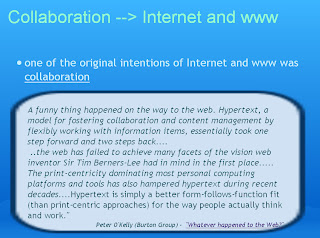.jpg)
This is an evolving article. If you want to see the result/conclusion look to the end of this article - "The true collaborative workspace"
(Check out this presentation which puts the collaborative web in a historic perspective)
The collaborative work:
- Any work we do is at one stage or another (if not all) collaborative in nature
- When we collaborate our work is enhanced and enriched (given more value)
- In any work we do, somebody (or something?) else in our work group/company/related companies or organizations (even or most surely competitors)/country/the world, is/has been/will be working on the same or related issues.
- Collaboration is the only true form of information/knowledge gathering
- Any knowledge worker and any knowledge company should have the ideal or close to the ideal collaborative workspace to foster and be a stewardship of knowledge (Information Dynamics)
- Any knowledge not shared is worthless
- This article/list has been produced (and will be enhanced) with collaborative efforts.
The current status of collaborative tools (the production of this article):
- How did it receive input / how was it produced?
- up until now with the help of Internet search, contacts the author knows (network) - the author's circle
- How can it be communicated? (to announce, to inform, to receive input, to enhance)
- what tools do we have today in our company:
- emails (limited to author's circle, don't know if receiver is the right one, email overload)
- meetings, lunch meetings (limited to geography, a challenge to find time or to prioritize the meeting at that time)
- exhibitions (a good an broad meeting place , but expensive and too seldom)
- they are all limited or incidental in nature
- what tools do we have today in our company:
- But how can it be enhanced/enriched/expanded???
Let's get some input - who else has said something about this issue
Collaboration and knowledge exchange has been an issue for all great minds and was actually one of the main goals of the inventors/pioneers of the World Wide Web. Perhaps we should go back to those roots and learn .....- The pioneers:
- As We May Think - The Atlantic (July 1945) by Vannevar Bush
Near the close of World War II, Vannevar Bush, the former director of the wartime Office of Scientific Research and Development, urged scientists to turn their energies from war to the task of making the vast store of human knowledge accessible and useful. The "infostructure" he sketched out—including a proposal for what might be seen as a kind of precursor to hypertext—was destined to be realized in what we now know as the Internet. - Tim Berners-Lee - the inventor of the World Wide Web and Hypertext (http)While an independent contractor at CERN from June to December 1980, Berners-Lee proposed a project based on the concept of hypertext, to facilitate sharing and updating information among researchers.[4]
- hypertext pioneer Doug Engelbart .......
- see his demo made 40 years ago
- "a collaborative improvement community aimed at spawning vast improvements in our organizations that will boost mankind's collective IQ to unforeseen heights". The Unfinished Revolution
- The CODIAK process -- collaborative, dynamic, continuous.
- see his demo made 40 years ago
- As We May Think - The Atlantic (July 1945) by Vannevar Bush
- The present
- The Future
- Semantic Web
- Tim Berners-Lee originally expressed the vision of the Semantic Web as follows:[7]
- I have a dream for the Web [in which computers] become capable of analyzing all the data on the Web – the content, links, and transactions between people and computers. A ‘Semantic Web’, which should make this possible, has yet to emerge, but when it does, the day-to-day mechanisms of trade, bureaucracy and our daily lives will be handled by machines talking to machines. The ‘intelligent agents’ people have touted for ages will finally materialize.
-
– Tim Berners-Lee, 1999
- See Tim Berners Lee on the Semantic Web (Web3.0)
- Og også denne nylige av Tim Berners-Lee på TED konferansen: http://www.ted.com/index.php/talks/tim_berners_lee_on_the_next_web.html
The true collaborative workspace
- When we put an article (which could be just a question) out on the collaborative workspace, the following happens:
- the article is automatically linked to all relevant information produced (self-configured view filters applied)
- anybody else working on the same or related issues will know of the presence of this article or question
- you can be informed of who these other persons/organisations are
- .....
- The true collaborative workspace is a place where we can spend most of our productive time
- It is automatically fed and updated with to-the-point relevant information of what you are working on / have an interest in
- The engine behind combines tagging, auto-tagging, smart search, etc. to produce this to the user
- All workflow flows through this main portal
- It is individual, based on your profile, interests and work assignment
- You can easily discover and collect contributions from people with similar focus as yourself across org borders
- Available information you need either flows to you or is easily searchable (include both internal and external sources).
- Views and searches can be time filtered.
- The tools to update/input/output should be generic and readily available to any collaborator (internal or external), any place and on any device that could http-communicate on the Internet.
- The content characteristics are not document/print centric, but rather compound, collaborative, interactive centric (see Whatever happened to the Web?)
- All relevant input are encouraged, available and appreciated - the wisdom of the crowd
- There are good mechanisms for interaction and contributions are rewarded
- The employee feel empowered and appreciated
- The company/employer will benefit from a lot more value and contributions from each employee





